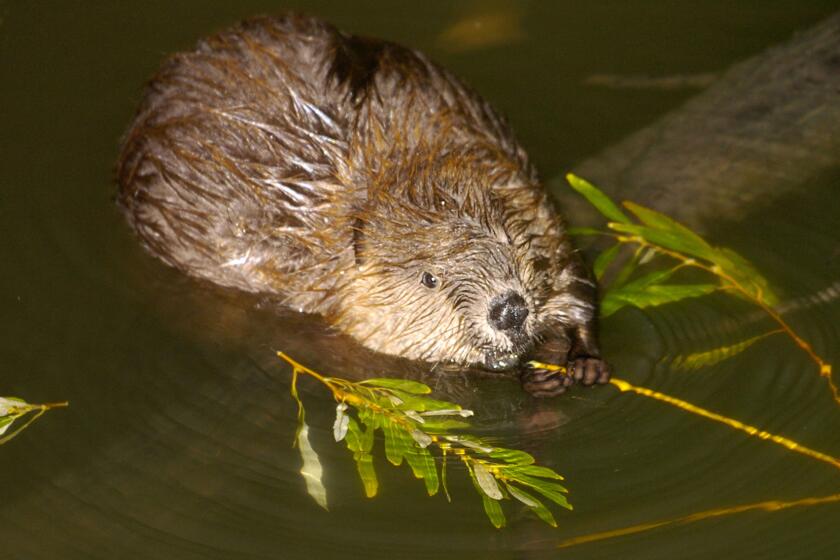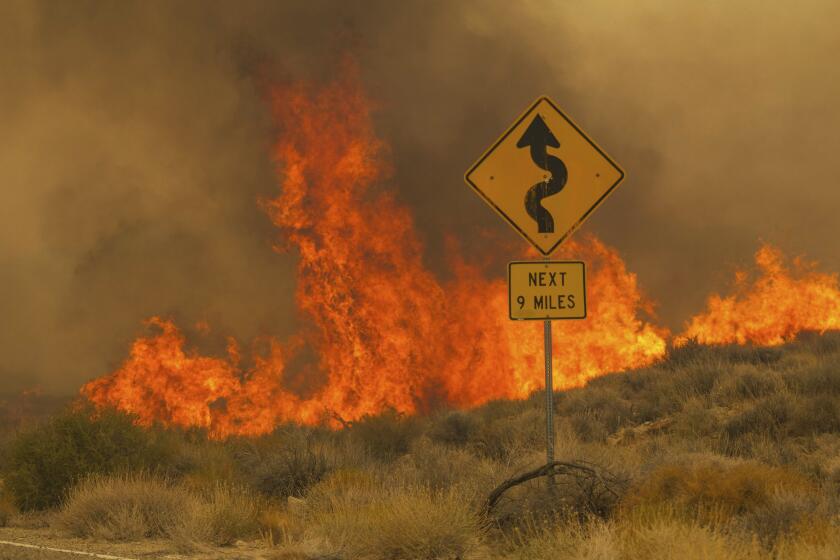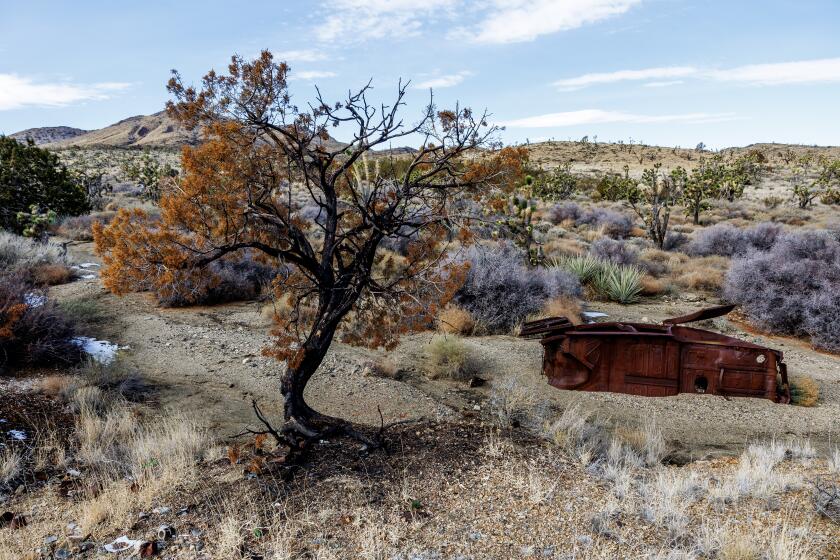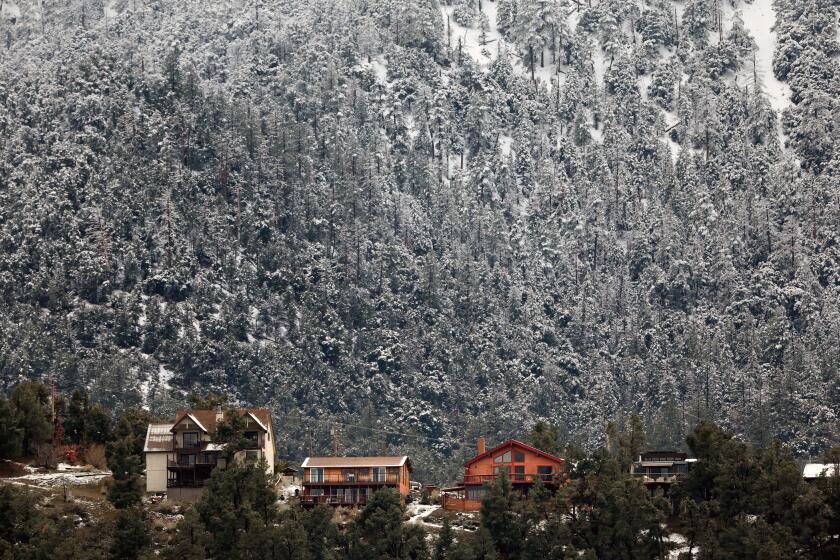A beaver complex in California, about an hour and a half north of Lake Tahoe, stayed green and healthy even as the Beckwourth Complex fire burned the surrounding landscape in 2021. (Emily Fairfax)
- Share via
A vast burn scar unfolds in drone footage of a landscape seared by massive wildfires north of Lake Tahoe. But amid the expanses of torched trees and gray soil, an unburnt island of lush green emerges.
The patch of greenery was painstakingly engineered. A creek had been dammed, creating ponds that slowed the flow of water so the surrounding earth had more time to sop it up. A weblike system of canals helped spread that moisture through the floodplain. Trees that had been encroaching on the wetlands were felled.
Aggressive and impactful reporting on climate change, the environment, health and science.
But it wasn’t a team of firefighters or conservationists who performed this work. It was a crew of semiaquatic rodents whose wetland-building skills have seen them gain popularity as a natural way to mitigate wildfires.
A movement is afoot to restore beavers to the state’s waterways, many of which have suffered from their absence.
“Beavers belong in California, and they should be part of our fire management plan,” said Emily Fairfax, assistant professor of geography at the University of Minnesota, who shot the drone footage of a series of beaver ponds along Little Last Chance Creek that remained green in the wake of the 2021 Beckwourth Complex fire.
Fairfax’s recent research found that beavers’ skills are useful even in the face of so-called megafires like the Beckwourth — a 105,000-acre behemoth whose burn scar was joined by that of the Dixie fire, which started weeks later and burned more than 960,000 neighboring acres.
“They basically build up an ecosystem that’s resilient to fire through the vegetation mosaic, then keep it really well watered so it never dries out, never becomes easy to burn,” she said.
Native to much of California, beavers were hunted to near extinction throughout North America by fur traders in the 1800s. Their numbers have rebounded in some areas, with populations in the Sierra Nevada, northeastern California and along the Salinas River Corridor from San Luis Obispo County to Monterey County, but they’ve had a hard time recovering overall.
The roly-poly rodents chew up and move around large amounts of plant material, damming streams to create ponds where they can hide from predators. They dig channels stretching from those ponds deeper into forests so they can forage for food without leaving the water. These activities can convert narrow streams into massive wetland complexes.
“They are just trying to build themselves a mega shopping mart so that they can go and get the groceries all the time, in all four seasons,” said Kate Lundquist, co-director of the nonprofit Occidental Arts & Ecology Center Water Institute. “And the result of that is you have these really resilient oases that won’t burn in a fire.”
Beavers can also help restore burned areas: Their dams trap ash and debris, and their wetlands help rehydrate landscapes, supporting the growth of grasses and shrubs, Lundquist said.
This can improve water quality, store carbon and support habitat for endangered species, disproportionately benefiting the entire ecosystem, said Brock Dolman, co-director of the Water Institute.
“All of these issues that we have state or federal laws and programs we’re spending hundreds of millions of dollars on to address, in many cases, beavers are showing up as a partner that can help us mitigate some of those,” he said.
But the same skills that make beavers such keen ecosystem engineers have also gained them enemies among farmers, ranchers and other landowners. Beavers’ dam-building and tree-chewing can flood roads and pastures and damage or destroy crops, timber stores and landscaping plantings.
Wildlife officials launch a restoration program for North American beavers, saying their dams can increase water storage and create natural firebreaks.
Still, their reputation as nuisance pests has been turning around.
“Over the recent decades, there’s really been this major paradigm shift surrounding how beavers are perceived,” said Valerie Cook, manager of the California Department of Fish and Wildlife’s beaver restoration program, which got up and running roughly a year ago and now has five dedicated staffers.
Last year, the department adopted a new policy formally recognizing beavers as a keystone species — those that play an outsized role in maintaining the diversity of their ecosystem — and encouraging landowners to try nonlethal methods for living with them before seeking approval to kill them.
The state has made available roughly $2 million in grant funding to landowners for these nonlethal methods, which can include sand-paint mixtures to deter beavers from chewing through trees, devices to prevent them from blocking up water control structures, and pond levelers that mitigate flooding by allowing water to flow through dams, Cook said. Tribes, public agencies and non-governmental organizations can apply to fund human-beaver coexistence projects.

Program staffers have also moved beavers from places where they’re coming into conflict with people and released them where they’re projected to do some good.
That kicked off in the fall with the reintroduction of a family of seven beavers into Tásmam Koyóm, a meadow on the ancestral land of the Mountain Maidu in Plumas County. One of the young beavers appears to have paired up with a resident beaver who already lived a bit downstream, Cook said.
More beavers are slated to be released this summer on the Tule River Reservation in the foothills of the southern Sierra, where the Tule River Tribe has long been a leader of beaver restoration efforts in the state.
Kenneth McDarment, former vice chairman, founded the tribe’s beaver project in 2014 as he watched the land grow parched and fire-prone amid years of drought.
“We were just trying to find another way to keep more water on the reservation for the people,” he said. “So that leads back to the tribe’s pictographs, where we have beavers.”
The roughly 1,000-year-old pictographs depict how various animals, including beavers, created the world. Beavers paddled in the waterways that wind through the reservation until several decades ago: A tribal elder recalls seeing them there when he was a boy, McDarment said.
“We thought, why not bring the beaver home?” he said.
Tribal members and partners have spent years preparing the area, building beaver dam analogues to create conditions conducive to their return, McDarment said. Meadows along those dammed riverscapes have already acted as wildlife safety zones during several fires that burned through the reservation over the past few years, he said.
They’ve also ensured there are plenty of plants for the beavers to eat and deep enough pools for them to escape from predators, he said. Those now include members of the Yowlumni wolf pack, which was discovered in the area last summer.
“We’ve been waiting to get to this point for a long time,” McDarment said. “It’s just a good feeling to finally receive them, to get to that point where we can watch them grow and watch them spread out and watch them do their thing on the creeks and river.”
The state’s beaver program is now soliciting proposals from other landowners who want beavers on their properties for restoration purposes, and staffers plan to select at least one additional project to tackle this year, Cook said. They are in the process of developing a scoring system for these proposals to triage where beavers can do the most good. One of the things they’ll be looking at is the probability of high-severity wildfire in the project area, she said.
Forecasters are anticipating a late start to California’s wildfire season, but they can’t yet say whether it will be severe.
Still, beavers aren’t a silver bullet for California’s wildfire problems, experts say. The state’s chaparral-studded hillsides and thickly forested mountain slopes have also grown more flammable due to interlocking legacies of human extraction, development and climate change. Those ecosystems require different interventions to restore their resilience to fire, Fairfax said.
“Beavers are really powerful within the riverscape and the river corridors, but they are not going to walk up hill slopes and mountainsides and deal with forests up there,” she said.
But within river corridors, beavers can play a key role in creating natural fire breaks by rewetting meadows and reducing the encroachment of forests, researchers have found.
“It’s a pretty simple concept of: wet a bigger, broader area and you’re going to keep fires at bay — at least to some degree,” said Karen Pope, aquatic ecologist with the U.S. Forest Service’s Pacific Southwest Research Station.
Beavers belong in California, and they should be part of our fire management plan.
— Emily Fairfax, University of Minnesota
Pope’s research has estimated that there were once nearly three times as many meadows in the Sierra. But during the Gold Rush, newcomers altered vegetation and destabilized riverbanks with grazing, at times draining meadows to make way for different land uses. People eventually built roads with flow-constricting culverts and depleted aquifers with irrigation and groundwater pumping, making it harder for rivers to connect to underground water stores.
As a result, some streams became deeply incised channels that act as drains, lowering the water table and encouraging conifers to move in where meadows once were, Pope said.
“Basically what we’re saying is, if we can do this restoration and these areas will stay wet late into the dry season, that’s one place you don’t have to maintain as a fuel break,” she said. “Nature maintains it as a fuel break.”
Pope’s latest research, conducted in the Sierra and Plumas national forests, focuses on how people can rewet meadows in both burned and unburned areas by doing things like building beaver dam analogues. Preliminary results, which have not yet been published, are positive — after these structures were installed, some depleted meadows began storing groundwater pretty much immediately, she said.
The goals of these interventions are twofold: restore the wetlands, and entice beavers to move in and maintain them, Pope said.
“The ultimate endpoint is to have the beavers come back in and say, ‘We like what you did,’” she said.
Last year’s York fire has sparked discussion about how to deal with conflagrations in the Mojave National Preserve.
Fairfax has become one of the nation’s top beaver evangelists, gaining fans with her stop-motion animation video showing how beaver wetlands can slow the intensity of wildfire, and for her concept of Smokey the Beaver as a counterpart to the Forest Service’s ursine poster child for fire suppression. She’s working with Google to build a machine learning model that can identify beaver dams in satellite imagery.
Her past research has found that beavers create refuges from wildfire : unburned or lightly crisped islands where plants and animals are able to survive amid flames. But there was some question as to whether that would still be the case during megafires, those that burn more than 100,000 acres and tend to have extreme, self-sustaining behaviors.
In their most recent study, Fairfax and fellow researchers used remote sensing to examine the burn severity of three megafires that burned in the Rocky Mountains in 2020. They found that 89% of the area around beaver ponds and dams qualified as fire refuges, versus 60% of riverscapes without beaver dams. These results are applicable to California, which also has coniferous forest and relies on snowpack to provide moisture during the relatively drier summer seasons, Fairfax said.
“Ecologically, this is like a bubble in the landscape that is what it was before the fire,” Fairfax said. “Even if everything else around it has been changed and is like a moonscape of burning, you have mature trees, grasses, living beavers, bobcats and other animals, and they can then go reproduce and repopulate that landscape after the fire.”
At Pine Mountain Club in Kern County, home and vehicle break-ins by bears are a recurring source of stress, as well as community division.














